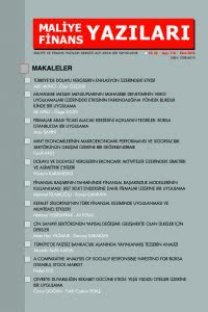Ticaret Savaşları: ABD, Meksika, Çin Örnekleri
Ticaret Savaşları, Optimal Denge, Nash, Korumacılık
Trade Wars: The Cases of USA, Mexico, China
Trade wars, Optimal tariffs, Nash, Protectionism,
___
- Akçadağ-Alagöz, E. (2016). Ekonomik Karşılıklı Bağımlılık Kapsamında AB-Çin İlişkileri, U.Ü. Sosyal Bilimler Enstitüsü Dergisi, Vol: 9, No: 2, 33-56.
- Aran, B. (2018). ABD, Çin, Ticaret Savaşları ve Türkiye, Türkiye Ekonomi Politikaları Araştırma Vakfı (TEPAV), Assestment Paper, No: N201813, 1-6.
- Bagwell, K., Staiger, R. W. (1999). An Economic Theory of GATT, American Economic Review, Vol. 89 (1), 215–248.
- Bagwell, K., Staiger, R.W. (2016). Handbook of Commercial Policy, North Holland, Amsterdam.
- Balistreri, E.J., Hillberry, R.H. (2017). 21st Century Trade Wars, Working Paper, https://www.gtap.agecon.purdue.edu/resources/download/8809.pdf
- Baumol, W.J., Blinder, A.S. (1985). Economic Principles and Policy, 3rd Edition, Harcourt, San Diego.
- Baybatlı, Ş. And Doğan, B. Ö. (2021). An Empirical Analysis on the Economic Reflections of Trade Wars: USA-China Case, Yalova Üniversitesi Sosyal Bilimler Dergisi,11(1), 17-36.
- Bchir, M. H., Decreux, Y. Guerin, J.L., Jean, S. (2002). MIRAGE, a Computable General Equilibrium Model for Trade Policy Analysis, CEPII, Working Paper No 2002-17.
- Bouet, A, Laborde, D. (2010). Assessing the Potential Cost of a Failed Doha, World Trade Review, Vol. 9, 319-351.
- Bouet, A. and Laborde, D. (2017). US Trade Wars with Emerging Countries in the 21st Century: Make America and Its Partners Lose Again, IFPRI Discussion Paper, No: 01669, Washington, DC.
- Brander, J. and Spencer, R. (1985). Export Subsidies and International Market Share Rivalry, Journal of International Economics, Vol.18, 83-100.
- Campbell, W. K. and Miller, J. K. (2007). International Encyclopedia of The Social Sciences, (2ND ED.), Cengage Learning, London.
- CIA (2017). The World Factbook, https://www.cia.gov/library/publications/the-world-factbook/
- Conybeare, J. A. (1987). Trade Wars: The Theory and Practice of International Commercial Rivalry, Columbia University Press, New York.
- Costinot, A., and Rodriguez-Clare, A. (2014). Trade theory with numbers, Handbook of International Economics, Vol.4, 211-224.
- Dorius, S. Y. and Xie, Y. (2022). Americans’ Attitudes toward the US–China Trade War, Journal of Contemporary China, 31:133, 17-37
- Eaton, J. and Grossman, G. (1986). Optimal Trade and Industrial Policy under Oligopoly, Quarterly Journal of Econonmics, Vol. 101, 383-406.
- Ertürk, N. (2017). Ticaret Savaşları ve Dünya Ekonomisine Etkileri, Fiscaoeconomia, 1(2), 88-112.
- Felicio, R. (2018). Trade Wars: When Nash Equilibrium Meets Deglobalization, http://cattolicaglobalmarketsmagazine.com/2018/03/26/trade-wars-nash-equilibrium-meets-deglobalization/
- Grossman, G. and Maggi, G. (1997). Free Trade versus Strategic Trade, a Peek into Pandora’s Box, NBER Working Paper: 6211.
- GTAP (2018). GTAP Data Bases, https://www.gtap.agecon.purdue.edu/databases/contribute/default.asp
- Hamilton, B. and Whalley, J. (1983). Optimal Tariff Calculations in Alternative Trade Models and Some Possible Implications for Current World Trading Arrangements, Journal of International Economics, Vol. 15 (4), 323-348.
- Irwin, D. A. (1991). Retrospectives: Challenges to Free Trade, Journal of Economic Perspectives, 5, 201-209.
- ITA (2017). Data & Analysis: International Trade Administration, US Department of Commerce, https://www.trade.gov/data.asp
- Kennan, J. and Riezman, R. (1988). Do Big Countries Win Tariff Wars?, International Economic Review, Vol. 29 (1), 81-85.
- Küçükaksoy, İ. (2010). Deregülasyon, Dış Ticaret Hadleri ve Refah İlişkileri, e-Journal of New World Sciences Academy, 5(2), 133-157.
- Nash, J. (1951). Non-Cooperative Games. Annals of Mathematics, 54(2), 286–295.
- OECD (2017). Trade in Value-Added database, www.oecd.org/industry/ind/measuringtradeinvalue-addedanoecd-wtojointinitiative.html
- Ossa, R. (2014). Trade Wars and Trade Talks with Data, American Economic Review, Vol. 104 (12), 4104-4146.
- Seyidoğlu, H. (2009). Uluslararası İktisat Teori Politika ve Uygulama, Güzem Can Yayınları, İstanbul.
- Spencer, B. (1986). What Should Trade Policy Target?, P. Krugman(revised), Strategic Trade Policy and the New International Economics, Cambridge: MIT Press, 23-46.
- Şanlı, O. And Ateş, İ. (2020). ABD – Çin Odalı Ticaret ve Kur Savaşlarının Dünya Ekonomisi Üzerindeki Etkileri, Aydın Adnan Menderes University Journal of Institute of Social Science, 7(1), 75-101.
- Tekbaş, M. and Yıldırım, M. (2016). G-8 Ülkelerinde Yeni Korumacılık Politikaları, Sosyal Bilimler Dergisi, Yıl: 3, Sayı: 9, 456-479.
- Tucker, J. (2016). Trump’s 35 percent tariff wouldn’t keep jobs in the U.S. Here’s why, https://www.washingtonpost.com/news/monkey-cage/wp/2016/12/08/trumps-35-percent-tariff-wouldnt-keep-jobs-in-the-u-s-heres-why/?noredirect=on&utm_term=.627768e0bc47
- Uysal, G. (2017). Nash Dengesi, Konferans Bildirgesi, Nash Dengesi ve Belirsizlik Altında Karar Verme Konferansı, Mart, 2017, İstanbul.
- Ünay, S. and Dilek, Ş. (2018). Yeni Korumacılık ve Ticaret Savaşları, SETA Analiz, Sayı: 228, SETA Siyaset, Ekonomi ve Toplum Araştırmaları Vakfı, İstanbul.
- WTO (2017). Members and Observers, https://www.wto.org/english/thewto_e/whatis_e/tif_e/org6_e.htm
- WTO (2018). Trade Profile, USA - China, http://stat.wto.org/CountryProfile/WSDBCountryPFView.aspx?Language=E&Country=US%2cCN
- ISSN: 1308-6014
- Yayın Aralığı: Yılda 2 Sayı
- Başlangıç: 2008
- Yayıncı: Maliye ve Finans Yazıları Yayıncılık Ltd. Şti.
Asya Ülkelerinin Yaşam Maliyeti Endeksinin Bütünleşik Analizi
Kırılgan Beşli Ülkelerinde Finansal Kurum Gelişmişliğinin Vergi Yükü Üzerindeki Etkisi
Hakan YILDIRIM, Yasin KARADENİZ
Türkiye'de Genel Bütçe Dengesi Ve Enflasyon: ARDL Sınır Testi Yaklaşımı
Dijital Bankacılık Uygulamalarına Covid-19’un Etkisi
Faiz Oranı Marjının Belirlenmesinde Belirsizliğin Banka Davranışı Üzerindeki Etkisi
Yabancı Portföy Yatırımların Ülke Seçim Kararı ile Ekonomik Özgürlük Endeksi Arasındaki İlişki
Cem KARTAL, Mürüvet ACAR KARABOĞA
Türkiye'de Erdemsiz Mallar Üzerindeki Özel Tüketim Vergilerinin Performans Değerlendirmesi
Türkiye'de Yeni Konut Fiyat Endeksini Etkileyen Faktörlerin Analizi
